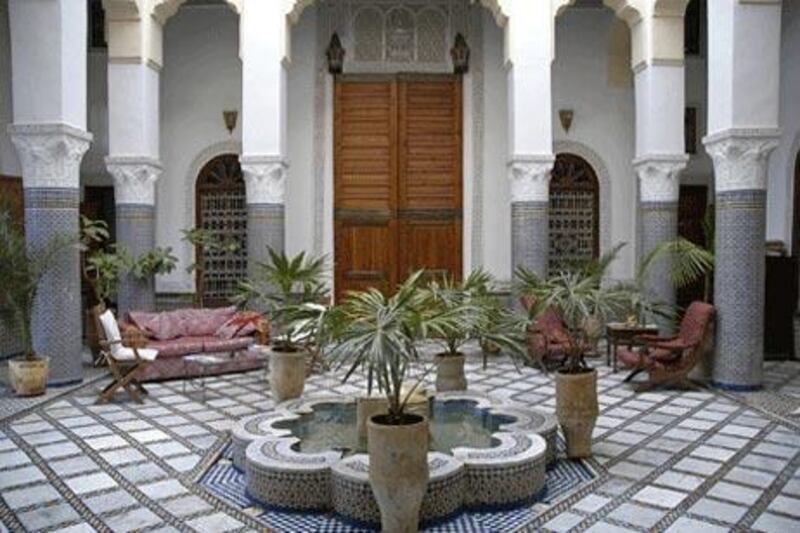There are people who risk causing neighbourhood warfare by growing seven-metre-high hedges of cypress or damas just to achieve the effect of an enclosed yard, so those who are lucky enough to have a genuine, high-walled courtyard, own an aristocrat among gardens. The strictly sequestered space has come to us in many guises down the ages: as the sacred heart of temples, churches and palaces, the gilded cage of the harem and women in purdah, the peristyle of the Roman villa, the heart of the traditional Arabian home - and it still features in every historic city in the world: chic in Paris; umbrageous and sensuous in London; secret, cobblestoned enclaves in Manhattan and Milan; glimpsed, mist-shrouded, through wrought iron gates in Venice. All great gardens have such deliberately concealed areas, because a courtyard is like a personal adytum, free from prying eyes and offering an almost antenatal security.
Of course, it is what you make it: verdant, exotic, ultra-modern, or traditional, but there is always a fundamental difference between the courtyard and the terrace. Being open, the latter is more conducive to generous entertainment, animation and music with a beat, whereas courtyards are more subtle and whisper of intimacy and intrigue. They need the sounds of water and birdsong, scented plants such as honeysuckle, heliotrope, lavender and lilies, and a seat curled around the base of a lemon or pomegranate tree perhaps, where two or three people can sit and talk.
Although the traditional permanent UAE house has a central courtyard, al hoash, this does not contain shrubs, trees or flowers. Instead, it is the family's private outdoor space, carpeted with clean sand and overlooked by a raised seating area for family activities and especially for women. However, when the Arabs took their exquisite gardens and advanced irrigation and horticultural techniques to Spain, the open central area within the houses there - which had been modelled on the Roman atrium - evolved into a courtyard garden, the patio.
Filled with plants climbing to and tumbling from tiers of internal galleries and creating lush, velvety shade, the patio is still one of the glories of Andalusian domestic design - to the extent that Cordoba holds a Patio Festival every May, during which the mysterious great town houses open to reveal extravaganzas of sunlit flowers as brilliant as a Tiffany's window display. Further north, old European courtyards of rose-filled beds and camomile are haunted by the ghosts of medieval princesses and unicorns, conspiring priests and plotting politicians, watchful monarchs and courtiers flaunting bulging calves and codpieces.
In contrast, the modern courtyard tends to favour textures and architecture: circles of slate shards in sweeps of gravel, granite spheres and pyramids, strategically placed boulders and metal topiary trees, oblongs of grass alternated with paving or in chessboard squares and, perhaps, a wall transformed by trompe d'oeil. Smart, stark style easily maintained and perfectly suited to city hustlers - and gardeners so lazy that they simply don't garden - although maybe not a lot to do with plants.
In fact, people living in city centres often prefer their courtyards to offer shelter from the surrounding blocks of offices and apartments and this is where dense foliage comes into its own. However, that doesn't mean funereal gloom. By planning a canopy of plants in strata, with the highest layer of tall, fine-leafed shrubs or trees, such as a delicately fronded caesalpinia, a pinnate-leafed golden rain bean tree (Cassia) or that Carmen Miranda of autumn, the stag's horn sumach (Rhus typhina), the light can filter through while invasive curiosity is filtered out.
Evergreens, such as the India rubber tree (Ficus elastica), Swiss cheese plant (monstera deliciosa), fatsia japonica and osmanthus, together with some of the smaller palms - Thrinax, Trachycarpus, Chamaedorea elegans, or the lipstick palm (Cyrtostachys renda) - can be draped as a living, scented burqa around your favourite spot. And, a boon to lazy gardeners, they need virtually no maintenance. If you're not entirely lazy you can plant up containers of bright flowers to place where shafts of sunlight beam down through the canopy.
One wall faced with a great feature climber - a blood-red bougainvillaea, or sky-blue ceanothus - creates surprise and interest. After dark, clever lighting can produce an underwater effect through all the gently breathing foliage. Ultimately, there is a shrine-like perfection about the classic, flag-paved rectangle with a central fountain or statue, symmetrically positioned square planters of spherical or cone-shaped topiary, stone bowls of scented flowers and a brick or rendered, exedra. This balance, proportion and formality create a contemplative atmosphere, making it a haven for thinkers and readers, and the writers of letters and diaries, a place to offer a prayer, to off load a care, or simply to enjoy a quiet cup of tea and the daily crossword.





